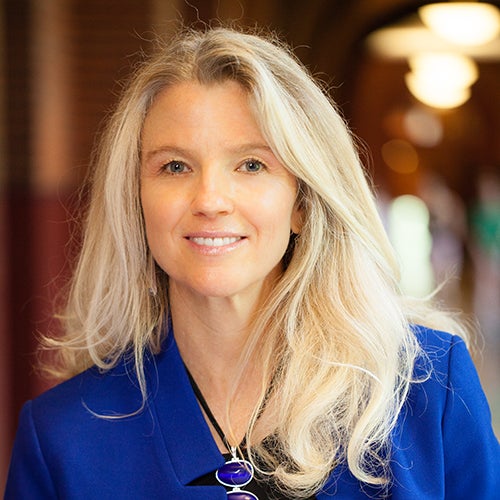Office Hours: Catherine Tinsley Explains Why Social Distancing Is So Hard

As humans, the impulse to maintain human connection runs deep. With the growing COVID-19 crisis, it has never been more difficult to stay connected, while being physically apart. Governments and medical experts are urging people around the world to change their daily behaviors, including social distancing, stay-at-home orders, and amping up personal hygiene efforts to prevent infection. Catherine Tinsley, Raffini Family Professor of Management at Georgetown University’s McDonough School of Business, explains why it’s so hard for many to remain apart from friends and family.
Why is it important for people to stay inside and/or socially distance?
Medical experts believe the most likely way to catch COVID-19 is from droplets of mucus or saliva that can be transmitted by someone infected coughing or sneezing. Thus, it’s not that staying inside is important (if you’re not sick), but staying away from others is critical — especially more vulnerable populations. It’s difficult to know who infected others are; therefore, the safest course of action is to stay six feet away from others.
Why isn’t the risk of contamination enough to keep people away from each other?
The ways in which we think about hazards in general and the uncertainty surrounding COVID-19 in particular make it difficult for us to believe it’s dangerous to be in contact with others. I’ve spent more than a decade studying “near-misses” and their unfortunate side effect of reducing our concerns about risk and lowering our protective actions.
A “near-miss” occurs when disaster is averted because of good luck: a hurricane veers off course at the last minute, sparing residents of a coastal city, or a car speeding through an intersection as the light turns red and avoids collision because there happens to be no cross traffic. In experiencing these near-miss events, we tend to ignore the role of good luck and “throw caution to the wind.” The coastal city residents feel less fear during future hurricane warnings, and the speeder will be even less cautious at the next intersection.
I see the same pattern happening now with physical distancing guidelines. Every time we ignore the guidance and have contact outside our household circle, and nothing evidently bad happens to us, we feel even more emboldened to breach the circle again. For example, assume I believed that there was a modest chance of getting infected by going out with friends, but I am bored, so I take that chance. The more often I go out, without any negative repercussions, the more likely I am to revise my thinking that social contact is not actually that risky. Now, I am likely to go out more often, because the chance of infection no longer feels risky. These near-miss experiences play on our gut-level feelings of whether or not something is dangerous. As our actual risks escalate with social contact, our feelings of risk de-escalate.
What consequences do those dwindling feelings of risk have?
The simple fact is this: The more we hang out with various others outside our household circle, the more we compound the risk of infection to ourselves and others in our community.
Compounding our difficulty with grasping just how risky social contact is for COVID-19 is the time lag between exposure and infection. If you mingle with others and do get infected with the virus, it usually takes several days to experience any symptoms. This delay between behavior and consequences makes it even harder for people to connect how their infection was the result of any particular behavior a week or even two weeks before.
How are different generations reacting to social distancing?
Younger generations tend to feel more invincible, with a higher discount rate on risky behavior. Couple that tendency with the near miss bias and delay of infection, and you have a perfect storm for an entire generation believing that occupying public spaces with their friends has no risk. The more people fight social distancing, the more they put themselves and more vulnerable populations at risk — and quite ironically, the less they feel that this behavior has any risk at all.
What else makes it difficult for us to continue to stay at home?
One final complicating factor hurting compliance with physical distancing guidelines stems from the uncertainty and inconsistency surrounding this novel coronavirus. Experts have disagreed, and protective guidance has changed. It can be overwhelming to keep up with current best practices for decreasing your risk of infection. Can you pick up the virus walking outside? Should we take our shoes off before coming into the house? Should we be disinfecting groceries? These evolving recommendations can lead us to throw out all medical guidance and just trust our own instincts.
What more can we do as a community to help reduce this behavior?
With many voices urging people to socially distance and stay home, it’s important for everyone to be on the same page and in agreement with the rules and regulations put in place for public safety. Mixed messages can be extraordinarily damaging when there are voices urging people to socially distance, while others are in close contact with each other. Many of those voices are not modeling the very behavior they advocate. Social distancing is difficult — and can go against our nature — but it can be crucial to flattening the curve and slowing the transmission of the virus.
